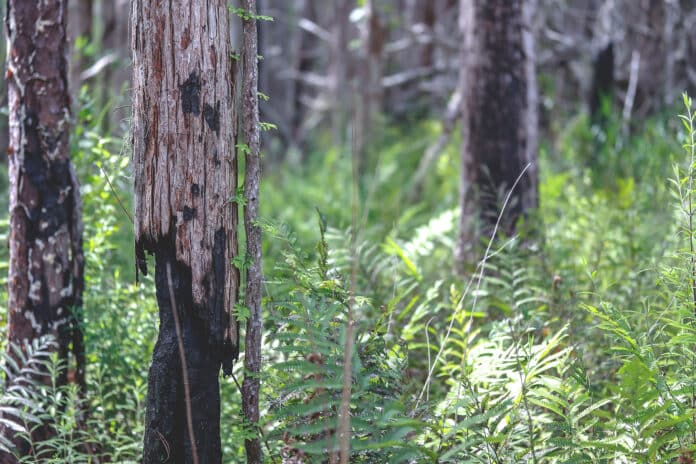Bob Lindemuth, Senior Forester, and Eryn Williamson, Park Service Specialist with Florida Forest Service, along with Brian Nelson Vegetation Management Manager with Southwest Florida Water Management District work to fight a severe ecological threat to the biological integrity of Florida’s natural systems, the Old World Climbing Fern (OWCF).
The name in itself has this intriguing middle-aged sound to it, but this particular fern is one of the most destructive non-native plant species in the State of Florida and spreading state-wide.
In 1965 the first known colonization was discovered in Martin County, and for over fifty years, this climbing fern has wreaked havoc. A great example of this devastation is happening in the Florida Everglades. It’s overtaking many of the cypress tree islands made up of some of Florida’s oldest cypress. But how did it get here to Florida? OWCF is native to the continents of Asia, Africa and Australia and was introduced to America as an ornamental.
OWCF releases thousands and thousands of spores that can be distributed by wind, wildlife, and people, but what is so complex about this fern is that it can grow in any habitat. It can grow in pine forests and even in wetland areas. The spore can root just above the ground surface and even within the crevice of a cypress tree. With that ability to grow in any habitat, it makes it challenging to prevent the spread of this fern.
“Within twenty years, there are areas that are completely covered. You can’t even see the canopy of the trees or anything,” Eryn Williamson said. “We are trying to prevent that from spreading northward.”
Keeping the new growth in check is imperative. New vines grow and climb within dead vines to create this dense intertwined mass. It can spread across smaller plant life, which prevents any native plants from growing. The vine depletes herbaceous ground cover that wildlife such as deer and wild turkey depend on for food.
“Like a lot of the invasives, especially with vines, it just blankets and carpets over everything so it impacts species diversity as far as our native plants,” said Southwest Florida Water Management District (SWFWMD) Vegetation Management Manager Brian Nelson.
Another danger is wildfires. Florida is the lightning capital of the country, and lightning strikes can cause wildfires. Mr. Nelson explained as the OWCF spreads upwards, and if the fire reaches the vine, it can create a canopy fire.
“Wetlands act as natural fire breaks, but if it’s full of OWCF, the fire will charge right through it,” Nelson said.
The hardest part of their job is locating these vines and 90 percent of the time it involves walking through dense vegetation as well as swamp areas. Both areas of Richloam Wildlife Management Area and Green Swamp Wilderness Preserve is an ideal habitat for OWCF to grow. Forestry and SWFWMD together have over 150,000 acres to cover and locate such a small-leaf vine.
The main objective is to control the earliest stages of growth. An herbicide is one way, but there is another option: biological control. The use of biological control (natural predators) is another way to stop the growth of invasive plant species. However, it’s a long process.
“Biocontrols take a decade or so to get approved. Not only do they have to find what’s feeding on it in its native land, but they need something that only feeds on its target plant,” Nelson said.
The District is cooperating with the USDA Agricultural Research Service to release the Brown Lygodium Moth and a herbivorous mite in the eastern part of the Green Swamp Wilderness Preserve. These species have made somewhat of an impact but may fall short on the agencies’ expectations.
The USDA Agricultural Research Service is currently examining two other species for biological control.

